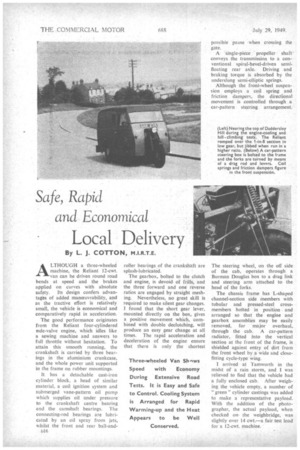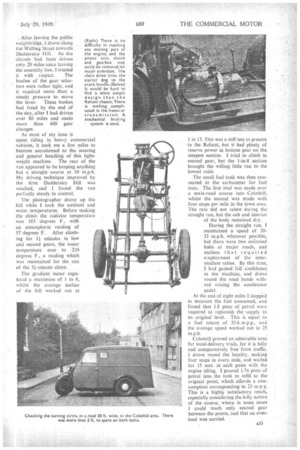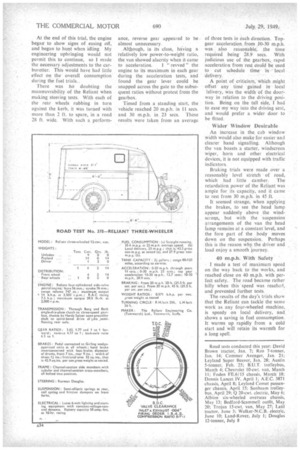Safe, Rapid and Economical
Page 22

Page 23

Page 24

If you've noticed an error in this article please click here to report it so we can fix it.
Local Delivery
By L. J. COTTON, M.I.R.T.E.
ALTHOUGH a three-wheeled machine, the Reliant 12-cwt. van can be driven round road bends at speed and the brakes applied on curves with absolute safety. Its design confers advantages of added manoeuvrability, and as the tractive effort is relatively small, the vehicle is economical and comparatively rapid in acceleration.
The good performance originates from the Reliant four-cylindered side-valve engine, which idles like a sewing machine and answers to full throttle without hesitation. To attain this smooth running, the crankshaft is carried by three bearings in the aluminium crankcase, and the whole power unit supported in the frame on rubber mountings.
It has a detachable cast-iron cylinder block, a head of similar material, a coil ignition system and submerged vane-pattern oil pump which supplies oil under pressure' to the crankshaft centre hearing and the camshaft bearings. The connecting-rod bearings are lubricated by an oil spray from jets, whilst the front and rear ball-and l6 roller bearings of the crankshaft are spla sh-i ub Heated.
The gearbox, bolted to the clutch and engine, is devoid of frills, and the three forward and one reverse ratios are engaged by straight meshing. Nevertheless, no great skill is required to make silent gear changes. I found that the short gear lever, mounted directly on the box, gives a positive movement which, combined with double declutching, will produce an easy gear change at all times. The rapid acceleration and deceleration of the engine ensure that there is only the shortest possible pause when crossing the gate.
A• single-piece propeller shaft conveys the transmission to a conventional spiral-bevel-driven semifloating rear axle. Driving and braking torque is absorbed by the underslung semi-elliptic springs.
Although the front-wheel suspension employs a coil spring and friction dampers, the directional movement is controlled through a car-pattern steering arrangement.
The steering wheel, on the off side of the cab. operates through a Burman. Douglas box to a drag link and steering arm attached to the head of the forks.
The chassis frame has L-shaped channel-section side members with tubular and pressed-steel crossmembers bolted in position and arranged so that the engine and gearbox assemblies may be easily removed, for major overhaul, through the cab. A car-pattern radiator, fitted into the vertical section at the front of the frame, is shielded against entry of dirt from the front wheel by a wide and closefitting cycle-type wing.
I arrived at Tamworth in the midst of a rain storm, and I was relieved to find that the vehicle had a fully enclosed cab. After weighing the vehicle empty, a number of " green " cylinder castings was added to make a representative payload. With the addition of the photographer, the actual payload, when checked on the weighbridge, was slightly over 14 cwt.—a fair test load for a 12-cwt. machine.
After, leaving the public weighbridge, I drove along the Watling Street towards Daddersley Hill. As .the chassis had been driven only 20 miles since leaving the assembly line. I treated it with respect. The bushes of the gear selectors were rather. tight, and it required more than a steady pressure to move
the lever. These bushes had freed by the end of the day, after I had driven over 80 miles and made more than 400 gear changes.
As most of my time is spent riding in heavy commercial vehicles, it took me a few miles to become accustomed to the Steering and general handling of this lightweight machine. The rear of the van appeared to be keeping anything but a straightcourse at 30 m.p.h. My driving technique improved by the time Daddersley Hill was leached, and I found the van perfectly steady to control.
The photographer drove up the hill while I took the ambient and water temperatures. Before making the climb the radiator temperature was 183 degrees f., with an atmospheric reading of 57 degrees F. After climb ing for I minutes in low and second gears, the water
temperature rose to 210 degrees F., a reading which was maintained for the .rest . of the 4-minute
The gradient meter registered a maximum of I in 8, whilst the average incline of the hill worked out at
I in 15. This was a stiff test to present to the Reliant, but it had plenty of reserve power in bottom gear on the steepest section. I tried to climb in second gear, but the 1-in-8 section brought the willing little van to the lowest ratio.
The small fuel tank was then connected to the carburetter for fuel tests. The first trial was made over a main-road course into Coleshill, whilst the second was made with four stops per mile in the town area. The rain did not relent during the straight run, but the cab and interior of the body remained dry. During the straight run, I maintained a speed of 3033 m.p.h. wherever possible, but there were two enforced halts at major roads, and inclines that required
• e.-nployment of the inter mediate ratios. By this time, I had gained full confidence• in the machine, and drove round the road bends without raising the accelerator pedal. •
At the end of eight miles I stopped to measure the fuel consumed, and found that 1.8 pints of petrol were required to replenish the supply to its original level. This is equal to a fuel return of 35.6 m.p.g., and the average speed worked out to 25 m.p.h.
Coleshill proved an admirable area for local-delivery trials, for it is hilly and comparatively free from traffic. I drove round the locality, making four stops to every mile, and waited for 15 secs. at each point with the engine idling. I poured 1.74 pints of petrol into the tank to refill to the original point, which affords a consumption corresponding to 23 m p g. This is a highly satisfactory result, especially considering the billy nature of the course, where in some cases 1 could reach only second gear between the points, and that an overload was carried.
At the end of this trial, the engine began to show signs of easing off, and began to hunt when idling. My engineering upbringing would not permit this to continue, so I made the necessary adjustments to the carburetter. This would have had little effect on the overall consumption during the fuel trials..
There was ha doubting the rnanceuvrability of the Reliant when making steering tests. With each of the rear wheels rubbing in turn against the kerb, it was turned with more than 2 ft. to spare, in a road 28 ft. wide. With such a. perform
ance, reverse gear appeared to be.. almost unnecessary, .Aftbough, in its class, having a relatively low power-to-weight ratio, the van showed alacrity when it came
to acceleration. I "revved " the engine to its maximum in each gear during the acceleration tests, and found the gear lever could be snapped across the gate to the subsequent ratios without protest from the gearbox.
Timed from a standing start, the vehicle reached 20 m.p.h. in II secs. and 30 m.p.h. in , 23 secs. These results were taken from an average of three tests in each direction. Topgear acceleration from I-0-30 m.p.h. was also reasonable, the time required being 28.9 secs. With judicious use of the gearbox, rapid acceleration from rest could be used to cut schedule time "in• local delivery. • A point of criticism,. Which might offset any time gained in local lelivery, was the width of the doorway in relation to the driving position. Being on the tall side, I had to ease my way into the driving seat, and would prefer a wider door to be fitted.
Wider Windbw, Desirable
An increase in the, cab window width would also make for easier and clearer hand signalling. Although the van boasts a starter, windscreen wiper, horn .and other electrical devices, it is not equipped with traffic indicators, Braking trials were made over a reasonably level stretch of road, which had little camber. The retardation .power of the Reliant was ample for its capacity, and it came to rest from 30 m.p.h. in 45 ft.
It seemed strange, when applying the brakes, to see the head lamp appear suddenly above the windset eep, but with the "suspension arrangements of the van the head ramp remains at a constant level, and the fore part of the body moves down on the suspension. Perhaps this is the reason why the driver and load enjoy a smooth journey.
40 With Safety I made a test of maximum speed on the way back to the works, and reached close on 40 m.p.h. with perfect safety. The road became rather hilly when this speed was reached, and prevented further tests.
The results of the day's trials show that the Reliant can tackle the same work as any four-wheeled machine, is speedy on local delivery, and shows a saving in fuel consumption. It warms up rapidly, from a cold start and will retain its warmth for a long spell.
Road tests conducted this year: David Brown tractor, Jan. 7; Reo 7-tanner, Jan. 14; Commer Avenger, Jan. 21; Leyland Super Beaver, Jan. 28; Austin 5-tonner, Feb. 25; BAIT. trolleybus, March 4; Chevrolet 10-cwt. van, March 11; Fatten FE.6/15 chassis, March' 18; Dennis Lancet IV, April 1; N,E,C. 3871 chassis, April 8; Leyland Comet passenger chassis, April 15; Sunbeam trolleybus, April 29; Q 20-cwt. electric, May 6; Albion six-wheeled overseas chassis, May 13; Bedford-Scammell outfit, May 20; Trojan 15-cwt. van, May 27; Latil tractor. June 3; Waiker-N.C.B. electric, June 10; Land-Rover, July I; Douglas 12-tonner, July 8


























